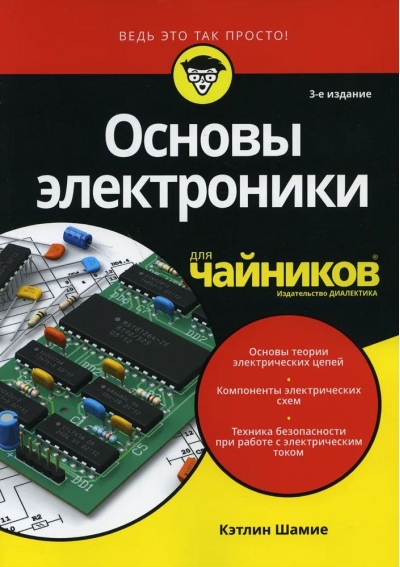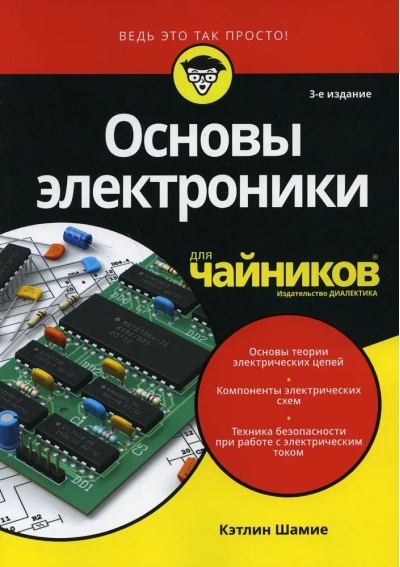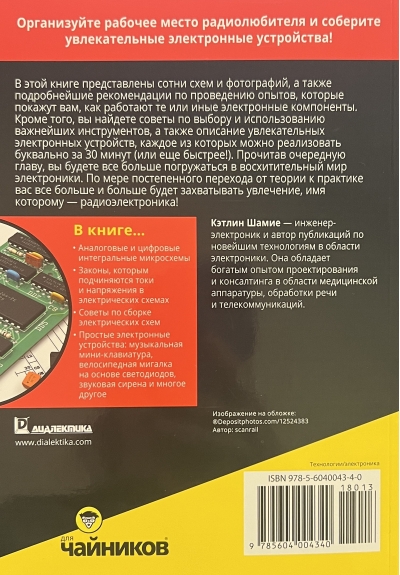Electronics Basics for Dummies
39.99 €
The only thing available 1
Organize your amateur radio workplace and start building exciting electronic devices without delay!
In this book you will find hundreds of schematics and photographs, as well as detailed experiment recommendations that will show you how various electronic components work. There are tips on choosing and using the most important tools, as well as descriptions of fascinating electronic devices, each of which can be realized in just 30 minutes (or even faster!). As you read the next chapter of the book, you will become more and more immersed in the fascinating world of electronics. As you gradually move from theory to practice, you will become more and more fascinated by the hobby, the name of which is radio electronics!
The basics of electrical circuit theory. You will learn what voltage is, which branches of electrical circuits can carry current and which cannot, and how power dissipation is calculated in electrical circuits.
Components of electrical circuits. You will learn how resistors, capacitors, inductance coils, diodes, and transistors control electric current and determine its shape.
Universal Circuits. You will learn how to use analog and digital integrated circuits to implement complex devices with minimal parts.
You will learn how to analyze electrical circuits. You will become familiar with the laws that govern current and voltage in electrical circuits and learn how to apply these laws in practice.
Safety tips for working with electrical current. Learn how to competently protect yourself and your electronic devices from electrical shock.
Learn:
- how to use tiny electronic components to control current;
- How the most common components of electronic circuits work;
- Why it's important to know Ohm's Law and other laws that electrical current obeys;
- how transistors can be used to amplify current and switch it in electrical circuits;
- what a 555 timer chip can do (and it can do a lot!);
- secrets of digital electronics;
- detailed tips on assembling electrical circuits;
- what fascinating devices you can quickly realize in practice.
Learn how to:
- control current with resistors, capacitors, and semiconductors;
- read electrical circuits;
- measure current, voltage and resistance;
- build a musical mini-keyboard, an LED-based bicycle flasher, a siren, and much more.
In this book you will find hundreds of schematics and photographs, as well as detailed experiment recommendations that will show you how various electronic components work. There are tips on choosing and using the most important tools, as well as descriptions of fascinating electronic devices, each of which can be realized in just 30 minutes (or even faster!). As you read the next chapter of the book, you will become more and more immersed in the fascinating world of electronics. As you gradually move from theory to practice, you will become more and more fascinated by the hobby, the name of which is radio electronics!
The basics of electrical circuit theory. You will learn what voltage is, which branches of electrical circuits can carry current and which cannot, and how power dissipation is calculated in electrical circuits.
Components of electrical circuits. You will learn how resistors, capacitors, inductance coils, diodes, and transistors control electric current and determine its shape.
Universal Circuits. You will learn how to use analog and digital integrated circuits to implement complex devices with minimal parts.
You will learn how to analyze electrical circuits. You will become familiar with the laws that govern current and voltage in electrical circuits and learn how to apply these laws in practice.
Safety tips for working with electrical current. Learn how to competently protect yourself and your electronic devices from electrical shock.
Learn:
- how to use tiny electronic components to control current;
- How the most common components of electronic circuits work;
- Why it's important to know Ohm's Law and other laws that electrical current obeys;
- how transistors can be used to amplify current and switch it in electrical circuits;
- what a 555 timer chip can do (and it can do a lot!);
- secrets of digital electronics;
- detailed tips on assembling electrical circuits;
- what fascinating devices you can quickly realize in practice.
Learn how to:
- control current with resistors, capacitors, and semiconductors;
- read electrical circuits;
- measure current, voltage and resistance;
- build a musical mini-keyboard, an LED-based bicycle flasher, a siren, and much more.
See also:
- All books by the publisher
- All books by the author



























